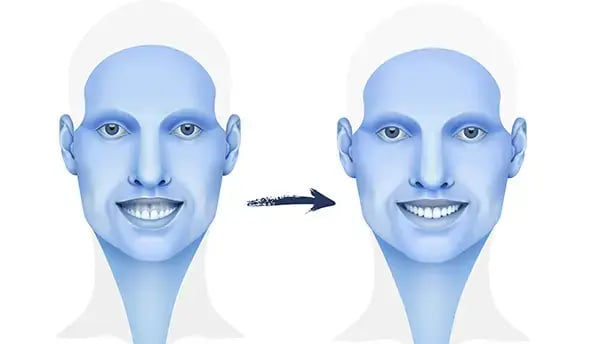What is Long Face Syndrome?
Understanding Long Face Syndrome
Long face syndrome, also known as vertical maxillary excess (VME) or skeletal open bite, is a craniofacial condition characterized by certain facial and dental abnormalities that result in an elongated facial appearance. This syndrome can have significant physical, functional, and psychological impacts on individuals who experience it. This essay will delve into the various aspects of long face syndrome, including its causes, symptoms, diagnosis, and treatment options.

What Causes Long Face Syndrome?
Long face syndrome typically arises from a combination of genetic, environmental, and developmental factors. Some of the key causes and contributing factors include:
1. Genetics: Genetic predisposition can play a significant role in the development of long face syndrome. A family history of the condition may increase the likelihood of an individual inheriting it.
2. Growth and development: During childhood and adolescence, the bones of the face and jaw grow and develop. Any disturbances in this process, such as excessive vertical growth of the maxilla (upper jaw bone), can lead to long face syndrome.
3. Thumb-sucking or pacifier use: Prolonged thumb-sucking or pacifier use can exert pressure on the developing oral structures, potentially contributing to the development of a long face and malocclusions.
Our mission is to create a world where every investment in modern beauty is Worth It.
Let's keep in touch
Get updates of the treatments you are interested
Symptoms
Long face syndrome presents a range of symptoms, which can vary in severity among individuals. Common symptoms include:
1. Excessive vertical facial height: One of the primary characteristics of long face syndrome is an elongated facial appearance, often accompanied by a pronounced lower facial third.
2. Open bite: Individuals with long face syndrome often have an open bite, where the upper and lower front teeth do not meet when the mouth is closed. This can lead to difficulties with chewing and speech.
3. Dental malocclusions: Misaligned teeth, crowded or spaced dentition, and other dental issues are common in individuals with long face syndrome.
4. Temporomandibular joint (TMJ) problems: The abnormal jaw structure can contribute to TMJ disorders, leading to pain, clicking, and limited jaw movement.
Diagnosis
Diagnosing long face syndrome typically involves a comprehensive evaluation by an orthodontist, oral surgeon, or maxillofacial specialist. The diagnosis may include:
1. Clinical assessment: A thorough examination of the patient's facial and dental features, including measurements and observations of facial proportions and tooth alignment.
2. Dental and facial imaging: X-rays, CT scans, and 3D imaging may be used to assess the structural abnormalities in the jaw and face.
3. Bite analysis: Evaluating the patient's bite and occlusion, including the presence of an open bite and any malocclusions.

How is Long Face Syndrome Treated?
The treatment of long face syndrome depends on the severity of the condition and its underlying causes. Treatment options may include:
1. Orthodontic treatment: Braces or clear aligners may be used to correct dental misalignments and improve bite alignment.
2. Orthognathic surgery: In cases of severe long face syndrome, surgical intervention may be necessary to reposition the upper or lower jaw. This procedure can address skeletal abnormalities and improve facial aesthetics and function.
3. Behavioral interventions: Early intervention to address thumb-sucking or pacifier use in children may help prevent the development of long face syndrome.
4. Speech therapy: If speech difficulties are present, speech therapy may be recommended to improve articulation and communication.

Pre-operative Preparation
Before undergoing surgery to correct Long Face Syndrome, patients typically undergo a comprehensive evaluation by a multidisciplinary team of healthcare professionals, including oral and maxillofacial surgeons, orthodontists, and, in some cases, plastic surgeons. This evaluation involves:
1. Medical History and Physical Examination: The surgeon will assess the patient's medical history and perform a thorough physical examination to ensure they are in good health for the procedure.
2. Orthodontic Evaluation: Orthodontists will evaluate the patient's dental and bite alignment to determine the extent of malocclusion and plan for postsurgical orthodontic treatment.
3. Radiographic Imaging: Advanced imaging techniques such as 3D cone-beam computed tomography (CBCT) scans are used to create detailed images of the facial bones, helping the surgical team plan the procedure accurately.
4. Treatment Planning: Based on the evaluation, a personalized treatment plan is developed, outlining the surgical approach, anticipated outcomes, and any necessary orthodontic treatment.
The Surgical Procedure
The surgical correction of Long Face Syndrome typically involves a procedure called orthognathic surgery, which aims to reposition the maxilla (upper jaw) and/or the mandible (lower jaw) to achieve a harmonious facial balance and improved function. Here's an overview of the surgical process:
1. Anesthesia: The surgery is performed under general anesthesia to ensure the patient is completely unconscious and pain-free during the procedure.
2. Incisions: Incisions are carefully made inside the mouth to minimize visible scarring. Depending on the specific case, the surgeon may perform a Le Fort I osteotomy (upper jaw) and/or a bilateral sagittal split osteotomy (lower jaw) to reposition the facial bones.
3. Bone Repositioning: The surgeon repositions the maxilla and/or mandible to correct the vertical excess and achieve the desired facial proportions and functional alignment.
4. Fixation: Small titanium plates and screws are used to secure the repositioned bones in their new alignment. These materials are biocompatible and usually do not require removal.
5. Closing Incisions: The incisions are sutured closed, and the surgical team ensures that the bite alignment is improved before finishing the procedure.
Our mission is to create a world where every investment in modern beauty is Worth It.
Let's keep in touch
Get updates of the treatments you are interested
Post-operative Recovery and Results
After surgery, patients can expect a period of recovery and adjustment, which includes the following aspects:
1. Hospital Stay: Depending on the complexity of the surgery and individual patient factors, a hospital stay of a few days may be required for monitoring and pain management.
2. Swelling and Bruising: Swelling and bruising of the face are common in the immediate post-operative period but gradually subside over several weeks.
3. Pain Management: Pain and discomfort are managed with prescribed medications, and patients are encouraged to follow a soft diet during the initial weeks to minimize stress on the surgical site.
4. Orthodontic Treatment: In most cases, orthodontic treatment continues post-surgery to fine-tune the bite alignment and ensure optimal functional and aesthetic outcomes.
5. Follow-up Visits: Patients have regular follow-up appointments with the surgical and orthodontic teams to monitor progress and make any necessary adjustments.
Over time, patients can expect significant improvements in their facial aesthetics and functional abilities. The full results of orthognathic surgery to correct Long Face Syndrome become apparent as the swelling subsides and the bones fully heal, typically within several months.
Surgery to correct Long Face Syndrome is a complex yet highly effective procedure that offers patients the opportunity to achieve a more balanced facial appearance and improved oral function. Pre-operative preparation, the surgical procedure itself, and post-operative care are all critical components of the process. While the recovery period may involve some discomfort and adjustment, the long-term benefits in terms of both aesthetics and function can be truly life-changing for individuals with Long Face Syndrome. It's important for patients to work closely with their healthcare team to ensure the best possible outcomes and a successful recovery.
Understanding Long Face Syndrome
Long face syndrome, also known as vertical maxillary excess (VME) or skeletal open bite, is a craniofacial condition characterized by certain facial and dental abnormalities that result in an elongated facial appearance. This syndrome can have significant physical, functional, and psychological impacts on individuals who experience it. This essay will delve into the various aspects of long face syndrome, including its causes, symptoms, diagnosis, and treatment options.

What Causes Long Face Syndrome?
Long face syndrome typically arises from a combination of genetic, environmental, and developmental factors. Some of the key causes and contributing factors include:
1. Genetics: Genetic predisposition can play a significant role in the development of long face syndrome. A family history of the condition may increase the likelihood of an individual inheriting it.
2. Growth and development: During childhood and adolescence, the bones of the face and jaw grow and develop. Any disturbances in this process, such as excessive vertical growth of the maxilla (upper jaw bone), can lead to long face syndrome.
3. Thumb-sucking or pacifier use: Prolonged thumb-sucking or pacifier use can exert pressure on the developing oral structures, potentially contributing to the development of a long face and malocclusions.
Our mission is to create a world where every investment in modern beauty is Worth It.
Let's keep in touch
Get updates of the treatments you are interested
Symptoms
Long face syndrome presents a range of symptoms, which can vary in severity among individuals. Common symptoms include:
1. Excessive vertical facial height: One of the primary characteristics of long face syndrome is an elongated facial appearance, often accompanied by a pronounced lower facial third.
2. Open bite: Individuals with long face syndrome often have an open bite, where the upper and lower front teeth do not meet when the mouth is closed. This can lead to difficulties with chewing and speech.
3. Dental malocclusions: Misaligned teeth, crowded or spaced dentition, and other dental issues are common in individuals with long face syndrome.
4. Temporomandibular joint (TMJ) problems: The abnormal jaw structure can contribute to TMJ disorders, leading to pain, clicking, and limited jaw movement.
Diagnosis
Diagnosing long face syndrome typically involves a comprehensive evaluation by an orthodontist, oral surgeon, or maxillofacial specialist. The diagnosis may include:
1. Clinical assessment: A thorough examination of the patient's facial and dental features, including measurements and observations of facial proportions and tooth alignment.
2. Dental and facial imaging: X-rays, CT scans, and 3D imaging may be used to assess the structural abnormalities in the jaw and face.
3. Bite analysis: Evaluating the patient's bite and occlusion, including the presence of an open bite and any malocclusions.

How is Long Face Syndrome Treated?
The treatment of long face syndrome depends on the severity of the condition and its underlying causes. Treatment options may include:
1. Orthodontic treatment: Braces or clear aligners may be used to correct dental misalignments and improve bite alignment.
2. Orthognathic surgery: In cases of severe long face syndrome, surgical intervention may be necessary to reposition the upper or lower jaw. This procedure can address skeletal abnormalities and improve facial aesthetics and function.
3. Behavioral interventions: Early intervention to address thumb-sucking or pacifier use in children may help prevent the development of long face syndrome.
4. Speech therapy: If speech difficulties are present, speech therapy may be recommended to improve articulation and communication.
What to Expect During Surgery to Correct Long Face Syndrome
Pre-operative Preparation
Before undergoing surgery to correct Long Face Syndrome, patients typically undergo a comprehensive evaluation by a multidisciplinary team of healthcare professionals, including oral and maxillofacial surgeons, orthodontists, and, in some cases, plastic surgeons. This evaluation involves:
1. Medical History and Physical Examination: The surgeon will assess the patient's medical history and perform a thorough physical examination to ensure they are in good health for the procedure.
2. Orthodontic Evaluation: Orthodontists will evaluate the patient's dental and bite alignment to determine the extent of malocclusion and plan for postsurgical orthodontic treatment.
3. Radiographic Imaging: Advanced imaging techniques such as 3D cone-beam computed tomography (CBCT) scans are used to create detailed images of the facial bones, helping the surgical team plan the procedure accurately.
4. Treatment Planning: Based on the evaluation, a personalized treatment plan is developed, outlining the surgical approach, anticipated outcomes, and any necessary orthodontic treatment.
The Surgical Procedure
The surgical correction of Long Face Syndrome typically involves a procedure called orthognathic surgery, which aims to reposition the maxilla (upper jaw) and/or the mandible (lower jaw) to achieve a harmonious facial balance and improved function. Here's an overview of the surgical process:
1. Anesthesia: The surgery is performed under general anesthesia to ensure the patient is completely unconscious and pain-free during the procedure.
2. Incisions: Incisions are carefully made inside the mouth to minimize visible scarring. Depending on the specific case, the surgeon may perform a Le Fort I osteotomy (upper jaw) and/or a bilateral sagittal split osteotomy (lower jaw) to reposition the facial bones.
3. Bone Repositioning: The surgeon repositions the maxilla and/or mandible to correct the vertical excess and achieve the desired facial proportions and functional alignment.
4. Fixation: Small titanium plates and screws are used to secure the repositioned bones in their new alignment. These materials are biocompatible and usually do not require removal.
5. Closing Incisions: The incisions are sutured closed, and the surgical team ensures that the bite alignment is improved before finishing the procedure.
Our mission is to create a world where every investment in modern beauty is Worth It.
Let's keep in touch
Get updates of the treatments you are interested
Post-operative Recovery and Results
After surgery, patients can expect a period of recovery and adjustment, which includes the following aspects:
1. Hospital Stay: Depending on the complexity of the surgery and individual patient factors, a hospital stay of a few days may be required for monitoring and pain management.
2. Swelling and Bruising: Swelling and bruising of the face are common in the immediate post-operative period but gradually subside over several weeks.
3. Pain Management: Pain and discomfort are managed with prescribed medications, and patients are encouraged to follow a soft diet during the initial weeks to minimize stress on the surgical site.
4. Orthodontic Treatment: In most cases, orthodontic treatment continues post-surgery to fine-tune the bite alignment and ensure optimal functional and aesthetic outcomes.
5. Follow-up Visits: Patients have regular follow-up appointments with the surgical and orthodontic teams to monitor progress and make any necessary adjustments.
Over time, patients can expect significant improvements in their facial aesthetics and functional abilities. The full results of orthognathic surgery to correct Long Face Syndrome become apparent as the swelling subsides and the bones fully heal, typically within several months.
Surgery to correct Long Face Syndrome is a complex yet highly effective procedure that offers patients the opportunity to achieve a more balanced facial appearance and improved oral function. Pre-operative preparation, the surgical procedure itself, and post-operative care are all critical components of the process. While the recovery period may involve some discomfort and adjustment, the long-term benefits in terms of both aesthetics and function can be truly life-changing for individuals with Long Face Syndrome. It's important for patients to work closely with their healthcare team to ensure the best possible outcomes and a successful recovery.






